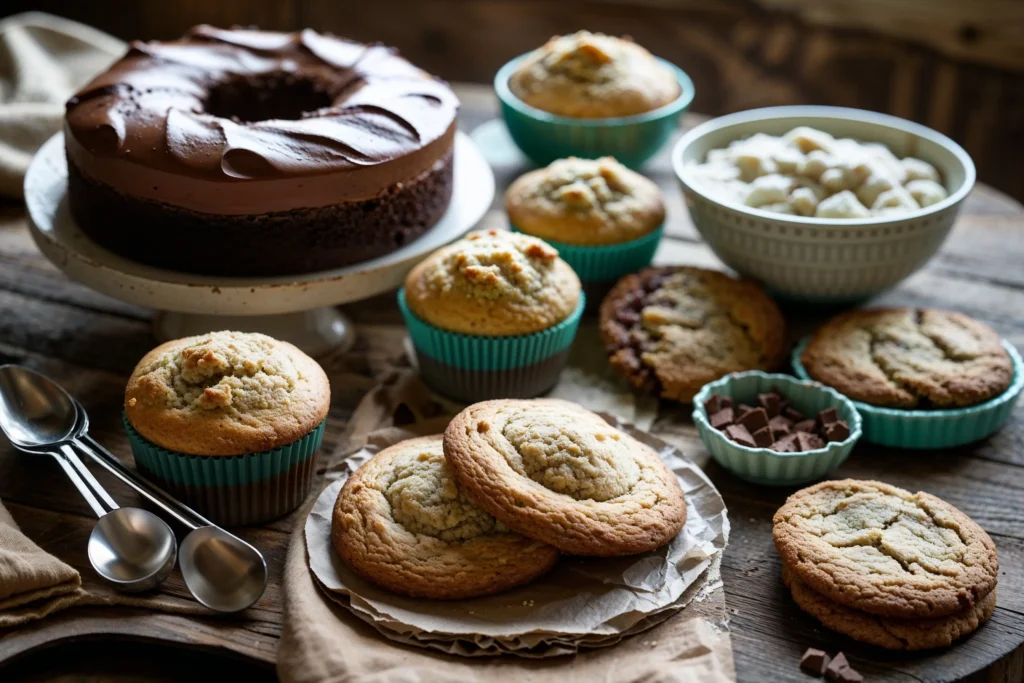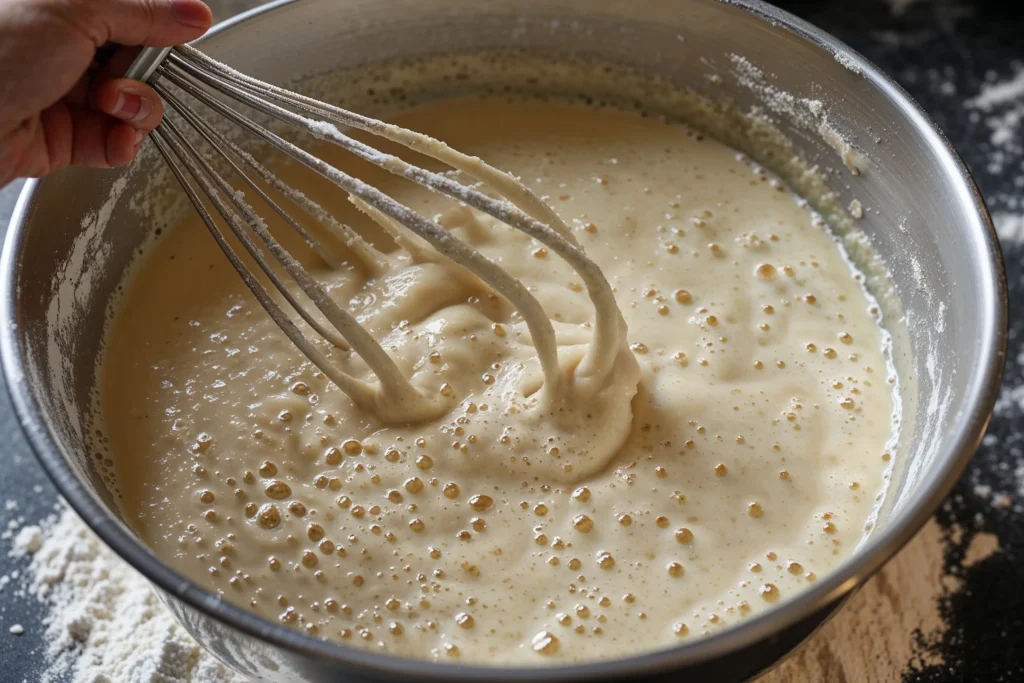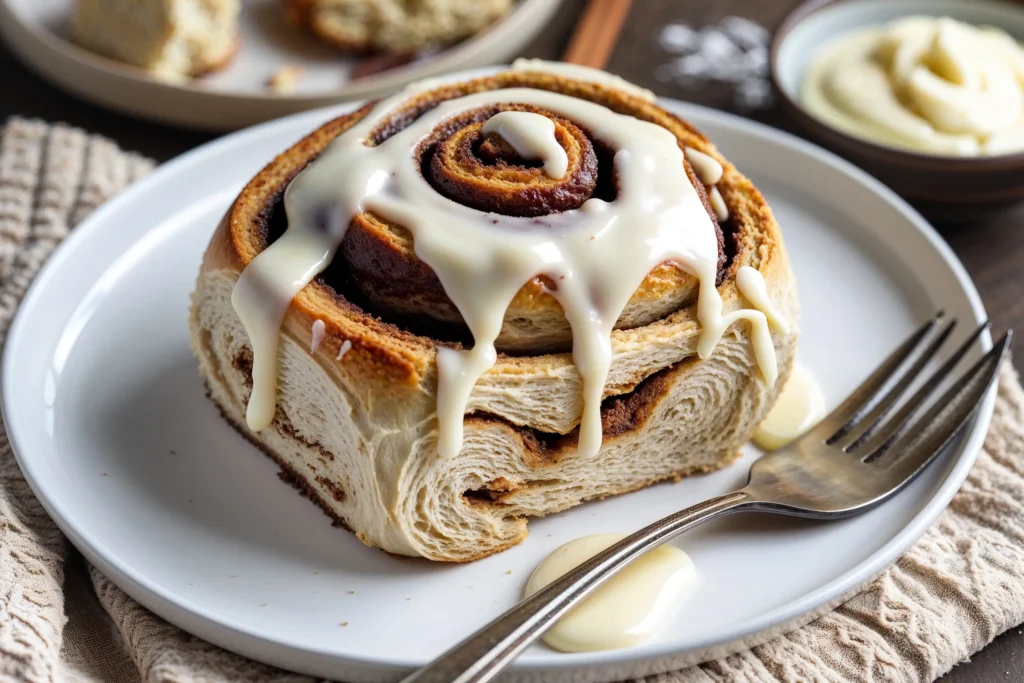Table of contents
Estimated reading time: 10 minutes
What Are Sourdough Dessert Recipes?
Sourdough dessert recipes are innovative ways to transform the traditional sourdough starter into sweet and flavorful treats. While sourdough is primarily known for its role in bread-making, it is also a fantastic ingredient in desserts, adding a tangy complexity that enriches the taste and texture of baked goods. This unique flavor profile creates desserts that are not overly sweet and have a satisfying depth.
At their core, these recipes use a sourdough starter, a natural mixture of fermented flour and water, either in its active state or as discard. This makes sourdough desserts an eco-friendly baking option since they help reduce food waste by utilizing leftover starter. The natural fermentation process not only develops rich flavors but also contributes to lighter textures in baked goods, making them more appealing to bake and enjoy.
Common examples of sourdough desserts include cakes, muffins, brownies, pancakes, and even cookies. The tangy notes from the starter pair wonderfully with sweet ingredients like chocolate, fruits, and spices, creating desserts with unparalleled taste. In addition to flavor, sourdough starters provide added nutritional benefits, such as improved digestion and enhanced nutrient absorption. For bakers looking to add variety and character to their dessert repertoire, sourdough recipes offer an exciting, sustainable, and delicious solution.
Common examples of sourdough desserts include cakes, muffins, brownies, pancakes, and even cookies. For those who enjoy creative twists on traditional treats, you might also like exploring other sweet ideas, such as Oreo dessert recipes, for inspiration.

The Science Behind Sourdough in Desserts
The magic of sourdough dessert recipes lies in the science of fermentation. Sourdough starter, a blend of flour and water teeming with wild yeast and bacteria, undergoes a natural fermentation process. This interaction between microorganisms not only helps baked goods rise but also infuses them with complex flavors and unique textures.
In desserts, the fermentation process works to break down starches in the flour, making the batter easier to mix and resulting in a finer crumb. The organic acids produced during fermentation provide a subtle tanginess, which pairs perfectly with sweet ingredients, creating a balanced flavor profile.
Beyond taste, sourdough fermentation enhances the texture of desserts by contributing to their moistness and softness. The starter’s natural leavening properties reduce the need for additional rising agents like baking powder, giving desserts a lighter and airier structure.
This process also brings nutritional benefits by improving digestibility and reducing gluten content in baked goods. Sourdough’s fermentation-driven qualities make it a powerful tool for bakers seeking flavorful, tender, and unique desserts with a distinctive edge.

Benefits of Using Sourdough in Dessert Recipes
Incorporating sourdough starter into dessert recipes offers a range of benefits, from flavor enhancement to improved texture and health perks. One of its standout features is the unique tanginess it adds, which complements the sweetness in desserts, resulting in a perfectly balanced taste. This subtle acidity sets sourdough desserts apart from traditional recipes, offering a more sophisticated flavor profile.
Texture-wise, sourdough fermentation creates desserts with a softer crumb and a moist, tender bite. The natural leavening process allows for a lighter structure, reducing the need for artificial rising agents. This process also helps improve the shelf life of baked goods by retaining moisture longer, keeping them fresh and enjoyable for days.
From a nutritional perspective, sourdough offers digestibility benefits. The fermentation breaks down gluten and phytic acid, which can improve nutrient absorption and make desserts gentler on the stomach. Using sourdough in dessert recipes is also eco-friendly, as it allows bakers to repurpose discarded starter, reducing food waste. For those seeking flavorful, textured, and health-conscious desserts, sourdough is a versatile and rewarding choice.
Essential Ingredients for Sourdough Desserts
Creating delicious sourdough dessert recipes requires a blend of key ingredients that work harmoniously with the sourdough starter to deliver exceptional results. The most critical component is the sourdough starter itself, which provides the natural leavening, tangy flavor, and tender texture that define these desserts. Active or discard sourdough starter can be used, depending on the recipe.
Flour is another foundational ingredient, with all-purpose flour being the most versatile option. For richer flavors, whole-grain or specialty flours like spelt or rye can add depth to the desserts. Sweeteners such as sugar, honey, or maple syrup balance the tanginess of the starter and enhance the dessert’s sweetness.
Liquids like milk, cream, or non-dairy alternatives help create the desired consistency in batters, while eggs are often included for structure and moisture. Butter or oils contribute richness, ensuring a tender crumb.
Flavor enhancers like vanilla, cinnamon, or citrus zest complement the sourdough’s natural tang. For mix-ins, options like chocolate chips, nuts, or dried fruits add texture and variety. Combining these essentials results in sourdough desserts that are flavorful, moist, and irresistible.
Equipment Needed for Sourdough Baking
To create delicious sourdough dessert recipes, having the right equipment is essential for consistent results. A sturdy mixing bowl is one of the most important tools, as it holds the sourdough starter and batter during preparation. Opt for a large, non-reactive bowl made of glass, ceramic, or stainless steel to prevent unwanted chemical interactions with the starter.
A kitchen scale is crucial for precise measurements, especially when working with sourdough starter, where accuracy can significantly impact the outcome. Measuring cups and spoons are also necessary for ingredients like sugar, liquids, and mix-ins.
A whisk and silicone spatula are invaluable for blending ingredients and ensuring even distribution of the starter. For mixing tougher doughs, a sturdy wooden spoon or stand mixer with a paddle attachment works well.
Baking pans or trays suited to the specific dessert, such as cake tins, muffin trays, or cookie sheets, are key. For even baking, parchment paper or silicone baking mats help prevent sticking. Finally, a cooling rack allows baked goods to cool evenly, preserving their texture and flavor. This essential equipment simplifies the sourdough baking process and guarantees delightful desserts.
Popular Sourdough Dessert Recipes You Must Try
Sourdough dessert recipes are a delightful way to experiment with your sourdough starter, offering unique flavors and textures. One favorite is sourdough chocolate cake, where the tanginess of the starter complements the richness of cocoa, creating a perfectly moist and decadent treat. For a breakfast-inspired dessert, sourdough pancakes or waffles bring a subtle tartness that balances with syrup and fresh fruit.
Another must-try option is sourdough brownies, where the fermentation adds a depth of flavor to the fudgy, chocolatey goodness. For cookie lovers, sourdough discard cookies are a fantastic way to reduce waste while baking a treat with a soft, chewy texture and a slight tang.
Seasonal favorites like sourdough pumpkin bread or sourdough cinnamon rolls showcase how well the starter pairs with spices and sweet fillings. If you enjoy fruity desserts, sourdough apple cake offers a rustic, flavorful option.
These recipes not only make the most of your starter but also create desserts that stand out for their flavor complexity and unique texture, making them a favorite for sourdough enthusiasts and dessert lovers alike.
Tips for Perfect Sourdough Desserts
Crafting sourdough dessert recipes that are consistently delicious requires attention to detail and some helpful tips. First, always use a sourdough starter that is active and bubbly, as this ensures proper fermentation and leavening. If you’re using discard, make sure it’s not too old to avoid overly acidic flavors.
Temperature plays a vital role in sourdough baking. Allow ingredients like butter, eggs, and starter to reach room temperature before mixing to promote even blending and better fermentation. Additionally, giving the batter time to rest after mixing allows the starter to activate and improve the flavor and texture.
Proper measurement is key, so rely on a kitchen scale for accuracy, particularly with the starter and flour. Mix gently to avoid overworking the batter, which can affect the dessert’s texture.
For baked goods, monitor baking times closely, as sourdough can brown faster due to the sugars in the starter. Lastly, experiment with flavors by pairing the sourdough’s tang with complementary ingredients like chocolate, citrus, or spices. These tips will help you achieve perfectly balanced and irresistible sourdough desserts every time.

How to Adapt Traditional Dessert Recipes to Sourdough
Transforming your favorite desserts into sourdough dessert recipes is an exciting way to introduce new flavors and reduce food waste. The key is incorporating sourdough starter while maintaining the balance of liquids, flour, and leavening agents in the recipe.
Start by substituting a portion of the flour and liquid in the recipe with sourdough starter. For instance, 1 cup of starter can typically replace ½ cup of flour and ½ cup of liquid. Be mindful of your starter’s hydration level, as it affects the overall consistency. If your starter is thicker, adjust the liquid content slightly to avoid dense results.
For recipes relying on chemical leaveners like baking powder or soda, you can often reduce these quantities. The fermentation in the starter provides some natural leavening, resulting in lighter textures. Allowing the batter to rest for 30 minutes before baking can further enhance flavors.
Finally, remember that sourdough adds a tangy note, so balance it by slightly increasing sweeteners or adding complementary flavors like vanilla, spices, or citrus. With practice, adapting traditional desserts to sourdough becomes a rewarding and creative baking technique.
Common Mistakes in Sourdough Desserts and How to Avoid Them
Creating sourdough dessert recipes can be a rewarding experience, but a few common mistakes can affect the final results. One frequent issue is using an inactive sourdough starter. A starter that isn’t properly fed or is too old may lack the fermentation power needed for flavor and texture. To avoid this, always use a fresh, bubbly starter or discard that’s been recently refreshed.
Another mistake is failing to adjust the liquid content in the recipe. Since sourdough starter already contains water, overlooking this can lead to overly wet batters. Reduce the liquid in your recipe to maintain the right consistency.
Over-mixing the batter is another pitfall. Excessive mixing can result in dense, tough desserts. Mix only until the ingredients are just combined to preserve tenderness.
Many bakers also overlook resting time, which is crucial for allowing the starter to work its magic. Let the batter rest for 30–60 minutes before baking to boost flavor and texture.
Finally, monitor baking times closely. Sourdough desserts may brown more quickly, so reduce the temperature slightly or check for doneness earlier. Avoiding these mistakes will lead to consistently delightful sourdough desserts.
Conclusion: Why You Should Try Sourdough Dessert Recipes Today
Sourdough dessert recipes offer a unique and rewarding way to experiment with baking, blending rich flavors with natural fermentation. By incorporating sourdough starter into your desserts, you can create treats with a tangy complexity and moist, tender textures that are hard to replicate using traditional methods. The process adds depth to simple ingredients, transforming familiar recipes into something extraordinary.
Beyond flavor and texture, sourdough baking promotes sustainability by repurposing starter discard, reducing food waste, and making the most of pantry staples. It also brings nutritional benefits, as fermentation can improve digestibility and nutrient absorption. For bakers who enjoy a creative challenge, sourdough opens the door to endless possibilities, from classic cakes to inventive cookies and brownies.
Whether you’re a seasoned baker or a beginner, sourdough desserts are worth exploring. They combine artistry, science, and sustainability into every bite, making the effort worthwhile. Start your journey with a simple recipe, and discover how sourdough can bring a new dimension to your baking repertoire today.
